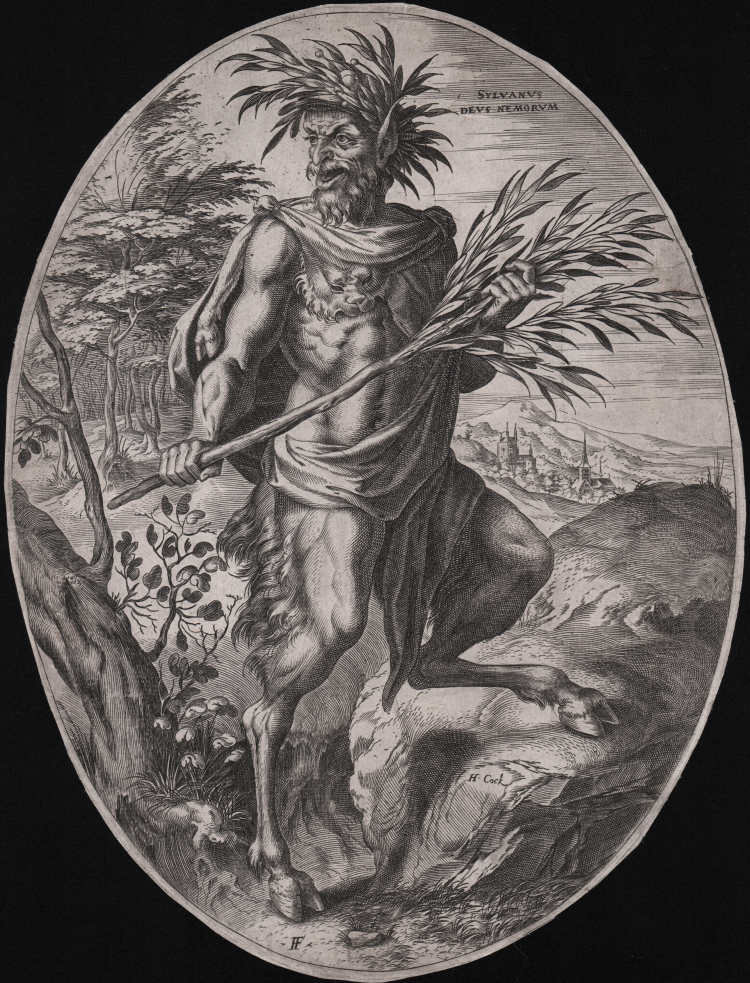




| Reference: | S44710 |
| Author | Cornelis CORT |
| Year: | 1565 |
| Measures: | 220 x 295 mm |



| Reference: | S44710 |
| Author | Cornelis CORT |
| Year: | 1565 |
| Measures: | 220 x 295 mm |
Sylvanus, full-length, a satyr carrying an olive branch, oval plate.
Engraving, 1565, after Frans Floris. Lettered upper right "SYLVANUS / DEUS NEMORUM". Below "H. Cock" and "FF".
From a series of six plates (New Hollstein 166-171) depicting “Rural Gods”.
Example of the first state of three, with the imprint of Hieronimus Cock.
Silvanus (Sylvanus) is derived from the Etruscan god Selvans, a protective divinity of nature and agrarian activities. Like the ancient deities of wilderness, he was considered fearsome and dangerous to infants and parturients. Because he was feared and revered by farmers, farmers used to appease the god before clearing a plot of land with a threefold ceremony invoking his protection over pastures, dwellings and the land itself. Originally "Silvanus," he was an epithet of the god Faunus or Mars and only later assumed the rank of an autonomous deity. He was often identified with Pan or Silenus, and his "numen" is often found juxtaposed with the figure of Mars. His worship was forbidden to women. His appearance was human, but he was sometimes depicted with goat thighs and legs and horns on his forehead. According to one legend, after Tarquinius the Superb was driven from Rome, the god warned the Etruscan army (eager to restore the ruler to his throne), not to attack the Romans, putting him to flight.
Frans Floris, also known as "Flemish Raphael," was actually greatly influenced by Michelangelo Buonarroti, whom he met during his long stay in Italy. A painter and engraver, he combined the art of the Italian Renaissance with the flair of the Flemish school, creating a school that would be followed until the advent of Rubens.
A fine impression, printed on contemporary laid paper, trimmed to the platemark, very good condition.
Bibliografia
New Hollstein (Dutch & Flemish) / The New Hollstein: Dutch and Flemish etchings, engravings and woodcuts 1450-1700 (99.I); Bierens de Haan 1948 / L'oeuvre gravé de Cornelis Cort, graveur hollandais 1533-1578 (169); Van de Velde 1975 / Frans Floris (1519/20-1570), Leven en Werken (60); Riggs 1977 / Hieronymus Cock, Printmaker and Publisher (77); Wouk, Frans Floris / Frans Floris (1519/20-1570): Imagining a Northern Renaissance. (99).
Cornelis CORT (Hoorn, nr Alkmaar, 1533 - Roma, prima del 22 Aprile 1578)
|
North Netherlandish engraver and draughtsman, active in Flanders and Italy. His first documented works are a series of engravings issued by the Antwerp publisher Hieronymous Cock, beginning c. 1553. Cort may have been an apprentice within Cock’s establishment, as none of these prints was inscribed with his name until after the plates had passed out of Cock’s hands. A letter of 1567 to Titian from the Netherlandish writer and painter Domenicus Lampsonius (1532–99) describes Cock as Cort’s master. By 1560 Cort had developed a bold and strongly modelled sculptural style of engraving, influenced in part by the Italian Giorgio Ghisi, who worked for Cock between 1550 and 1555. Cort was particularly successful in reproducing the Italianate figure compositions of Frans Floris, after whom he engraved more than 50 prints, notably the Liberal Arts (seven prints; 1565) and the Labours of Hercules (ten prints; 1565). He also reproduced compositions by Maarten van Heemskerck, Andrea del Sarto, Rogier van der Weyden and others while working for Cock.
|
Cornelis CORT (Hoorn, nr Alkmaar, 1533 - Roma, prima del 22 Aprile 1578)
|
North Netherlandish engraver and draughtsman, active in Flanders and Italy. His first documented works are a series of engravings issued by the Antwerp publisher Hieronymous Cock, beginning c. 1553. Cort may have been an apprentice within Cock’s establishment, as none of these prints was inscribed with his name until after the plates had passed out of Cock’s hands. A letter of 1567 to Titian from the Netherlandish writer and painter Domenicus Lampsonius (1532–99) describes Cock as Cort’s master. By 1560 Cort had developed a bold and strongly modelled sculptural style of engraving, influenced in part by the Italian Giorgio Ghisi, who worked for Cock between 1550 and 1555. Cort was particularly successful in reproducing the Italianate figure compositions of Frans Floris, after whom he engraved more than 50 prints, notably the Liberal Arts (seven prints; 1565) and the Labours of Hercules (ten prints; 1565). He also reproduced compositions by Maarten van Heemskerck, Andrea del Sarto, Rogier van der Weyden and others while working for Cock.
|